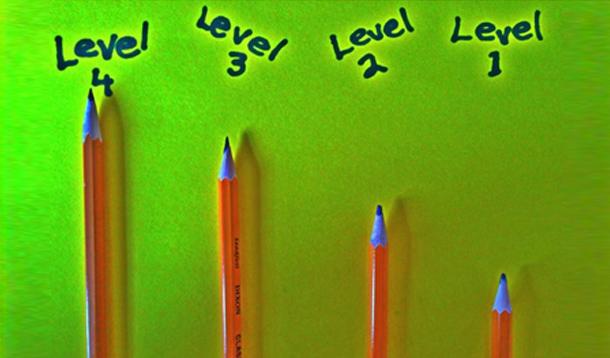
I’m not quite old enough to have been educated in a one-room schoolhouse, but I definitely attended school in a simpler time. I grew up receiving hand-written report cards, before computer technology was a required subject and before week-long standardized testing reduced kids to tears. Back then students still failed and skipped grades and comments on the top of a kid’s work read things like, “Great job” and “Fantastic.” It seemed like everything my classmates and I completed was synonymous with “outstanding” and usually handed back to us adorned with a shiny foil star. Ah, those were the days!
However, education, like most things, continues to grow and evolve and the grading system is no exception. Wise teachers and principals came to realize that telling every student that they are “super” doesn’t push kids to strive for better or help them recognize areas for improvement. I definitely agree. Students of any age respond better to direct, descriptive feedback than they do to vague words of praise. Enter the rubric. It’s not exactly new, but to parents who are used to letter or percentage grades, this may seem like an entire shift in the system of academic evaluation.
A rubric is generally a document that outlines the specific expectations for a project, paper, or scholarly endeavour.
Rubrics were originally designed to assess student writing, but now they are being used all over the curriculum, from gym class to the science lab and all subjects in between. There are some big pushes in education these days, such as project-based learning and student-led evaluation, which lend themselves to being graded with a rubric. These handy charts are used to assess many standardized provincial tests, such as Ontario’s dreaded EQAO. The Ministry of Education documents are littered with rubrics and teachers are expected to use them as often as possible.
So here’s what you need to know. Basically a rubric is just a chart that tells a student what is expected of them. Teachers will then use that chart to grade the student’s performance on a task. Rubrics should be given to students at the beginning of the assignment — the idea is that all the expectations are communicated before the kids embark on their project. These charts are usually divided into four levels, although some teachers use five. In a four-level rubric, level four is the highest and level one is the lowest. Basically, if your student is level three, it means he or she is where the system expects — the student is meeting the provincial standard. If students are at level four, they are exceeding expectations and if they are at level two, they are approaching expectations. Level one is when you need to worry. That implies your student is not producing or demonstrating her understanding at a sufficient level.
Most rubrics are set up as a table, with the four levels across the top and specific categories the teacher is assessing on the side. For example, a teacher looking at a writing piece may assess these categories: ideas, conventions (spelling, grammar, punctuation), author’s voice and presentation. The chart may say something like, “Level Four, Author’s Voice: gives a clear message and consistently shows the writer’s personality.” The idea is that rubrics are less subjective, but obviously grading is still skewed, as words like “consistently," “personality," and “clear” remain open to interpretation.
The levels do not exactly equate to letter or percent grades (a level four isn’t necessarily an A, level 3 a B, etc.) but school boards continue to use a letter grades for report cards, so teachers often do line up the rubric levels with more the traditional grading system.
So, what can you do as a parent to help your child who is being assessed with these rubrics?
1) Don’t be intimidated by the jargon. Rubric is just a fancy word for an assessment chart and if the teachers are doing their jobs well, both you and your kids will know this early on in your child’s school years.
2) Understand the direction of the rubric for communication with the school (level 4 = yippee, level 1 = yikes).
3) Ask your children to show you the rubric when they tell you about a project. If they don’t have it, feel free to ask the teacher to give on to you. You are entitled to know up front how your child will be evaluated. Obviously, a teacher isn’t going to create a rubric for every piece of work that is assessed, but there will definitely be one in place for larger pieces of writing, projects, and the like.
4) If you have the time prior to submitting work, have your students highlight the rubric showing where they feel they achieved for each expectation. Later you can compare the students' perception of their skills with the teacher’s assessment. This can teach both you and your child a lot about their ability to self evaluate.
5) Every once in awhile, be sure to shove all the rubrics, percentiles, and report cards in a deep, dark drawer somewhere and just have fun with your kids. The best way to create anxiety in your children around grades and assessment is to be anxious yourself. Don’t worry, it’ll all be ok! Whether striving for level 4 or an A+, remember school is just one part of your kid’s life.
Keep smiling and enjoy the journey!